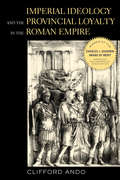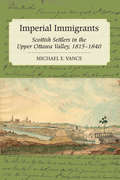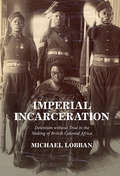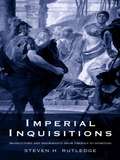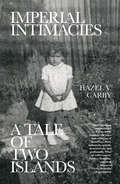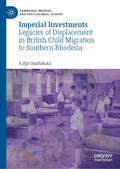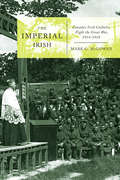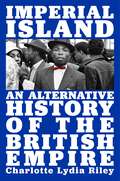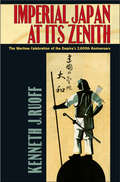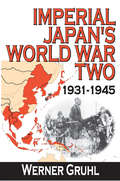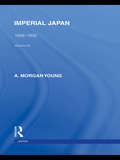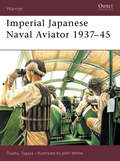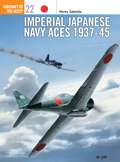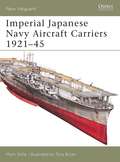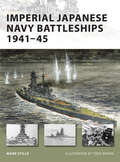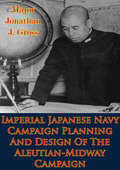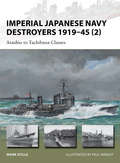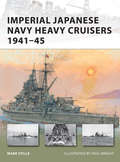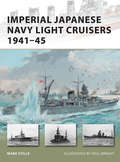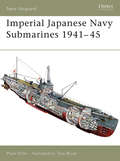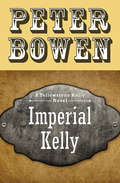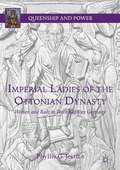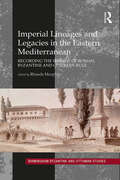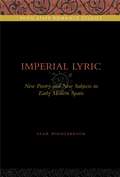- Table View
- List View
Imperial Ideology and Provincial Loyalty in the Roman Empire
by Clifford AndoThe Roman empire remains unique. Although Rome claimed to rule the world, it did not. Rather, its uniqueness stems from the culture it created and the loyalty it inspired across an area that stretched from the Tyne to the Euphrates. Moreover, the empire created this culture with a bureaucracy smaller than that of a typical late-twentieth-century research university. In approaching this problem, Clifford Ando does not ask the ever-fashionable question, Why did the Roman empire fall? Rather, he asks, Why did the empire last so long? Imperial Ideology and Provincial Loyalty in the Roman Empire argues that the longevity of the empire rested not on Roman military power but on a gradually realized consensus that Roman rule was justified. This consensus was itself the product of a complex conversation between the central government and its far-flung peripheries. Ando investigates the mechanisms that sustained this conversation, explores its contribution to the legitimation of Roman power, and reveals as its product the provincial absorption of the forms and content of Roman political and legal discourse. Throughout, his sophisticated and subtle reading is informed by current thinking on social formation by theorists such as Max Weber, Jürgen Habermas, and Pierre Bourdieu.
Imperial Immigrants: The Scottish Settlers in the Upper Ottawa Valley, 1815–1840
by Michael E. VanceThe impact of the British Empire on the history of the Upper Ottawa Valley is explored through the experiences of early emigration-assisted 19th-century Scottish immigrants. Between 1815 and 1832, Great Britain settled more than 3,500 individuals, mostly from the Scottish Lowlands, in the Ottawa Valley. These government-assisted emigrations, which began immediately after the Napoleonic Wars, are explored to reveal their impact on Upper Canada. Seeking to transform their lives and their society, early Scots settlers crossed the Atlantic for their own purposes. Although they did not blindly serve the interests of empire builders, their settlement led to the dispossession of the original First Nation inhabitants, thus supporting the British imperial government’s strategic military goals. After transferring homeland religious and political conflict to the colony, Scottish settlers led the demand for political reform that emerged in the 1830s. As a consequence, their migration and settlement reveals as much about the depth of social conflict in the homeland and in the colonies as it does about the preoccupations of the British imperial state.
Imperial Incarceration: Detention without Trial in the Making of British Colonial Africa (Studies in Legal History)
by Michael LobbanFor nineteenth-century Britons, the rule of law stood at the heart of their constitutional culture, and guaranteed the right not to be imprisoned without trial. At the same time, in an expanding empire, the authorities made frequent resort to detention without trial to remove political leaders who stood in the way of imperial expansion. Such conduct raised difficult questions about Britain's commitment to the rule of law. Was it satisfied if the sovereign validated acts of naked power by legislative forms, or could imperial subjects claim the protection of Magna Carta and the common law tradition? In this pathbreaking book, Michael Lobban explores how these matters were debated from the liberal Cape, to the jurisdictional borderlands of West Africa, to the occupied territory of Egypt, and shows how and when the demands of power undermined the rule of law. This title is also available as Open Access on Cambridge Core.
Imperial Inquisitions: Prosecutors and Informants from Tiberius to Domitian
by Steven H. RutledgeDelatores (political informants) and accusatores (malicious prosecutors) were a major part of life in imperial Rome. Contemporary sources depict them as cruel and heartless mercenaries, who bore the main responsibility for institutionalising and enforcing the 'tyranny' of the infamous rulers of the early empire, such as Nero, Caligula and Domitian. Stephen Rutledge's study examines the evidence to ask if this is a fair portrayal.Beginning with a detailed examination of the social and political status of known informants and prosecutors, he goes on to investigate their activities - as well as the rewards they could expect. The main areas covered are: * checking government corruption and enforcing certain classes of legislation * blocking opposition and resistance to the emperor in the Senate* acting as a partisan player in factional strife in the imperial family* protecting the emperor against conspiracy.The book includes a comprehensive guide to every known political informant under the early empire, with their name, all the relevant primary and secondary sources, and an individual biography.
Imperial Intimacies: A Tale of Two Islands
by Hazel V. CarbyA haunting and evocative history of British empire, told through one woman’s search through her family’s story“Where are you from?” was the question hounding Hazel Carby as a girl in post–World War II London. One of the so-called brown babies of the Windrush generation, born to a Jamaican father and Welsh mother, Carby’s place in her home, her neighbourhood, and her country of birth was always in doubt. Emerging from this setting, Carby untangles the threads connecting members of her family to each other in a web woven by the British Empire across the Atlantic. We meet Carby’s working-class grandmother Beatrice, a seamstress challenged by poverty and disease. In England, she was thrilled by the cosmopolitan fantasies of empire, by cities built with slave-trade profits, and by street peddlers selling fashionable Jamaican delicacies. In Jamaica, we follow the lives of both the “white Carbys” and the “black Carbys,” as Mary Ivey, a free woman of colour, whose children are fathered by Lilly Carby, a British soldier who arrived in Jamaica in 1789 to be absorbed into the plantation aristocracy. And we discover the hidden stories of Bridget and Nancy, two women owned by Lilly who survived the Middle Passage from Africa to the Caribbean. Moving between the Jamaican plantations, the hills of Devon, the port cities of Bristol, Cardiff, and Kingston, and the working-class estates of South London, Carby’s family story is at once an intimate personal history and a sweeping summation of the violent entanglement of two islands. In charting British empire’s interweaving of capital and bodies, public language and private feeling, Carby will find herself reckoning with what she can tell, what she can remember, and what she can bear to know.
Imperial Investments: Legacies of Displacement in British Child Migration to Southern Rhodesia (Cambridge Imperial and Post-Colonial Studies)
by Katja UusihakalaThis book examines the legacy of a British child migration scheme that relocated British children to Southern Rhodesia between 1946 and 1962, with the aim of populating the colony with “fresh white stock”. The selected children were resettled at Rhodesia Fairbridge Memorial College, a boarding school established in a disused RAF airbase outside the town of Bulawayo. This social engineering project sought to “rescue” children from what were predicted as undesirable futures in Britain and offer them a “better life” with prospects of social advancement. Yet, beyond individual salvation, the scheme emigrated the children with the intention that they would help sustain the racially segregated colonial order. Building on long-term ethnographic research with former Rhodesian child migrants, now living in the UK, South Africa, Australia, and New Zealand, this book delves into the children’s unique experiences of migration, displacement, and resettlement. By highlighting these enduring emotional, social, and political repercussions, the author critically addresses how colonial histories matter in the present. Through the lens of former child migrants – whose kin relations were ruptured, who were disciplined into silence and suppression, and who have seen scant public recognition of their past – this book sheds light on the formation of memory through its gaps and silences. It contributes to our understanding of memory in relation to forced migration and displaced communities.
Imperial Irish: Canada’s Irish Catholics Fight the Great War, 1914-1918 (McGill-Queen's Studies in the History of Religion)
by Mark G. McGowanBetween 1914 and 1918, many Irish Catholics in Canada found themselves in a vulnerable position. Not only was the Great War slaughtering millions, but tension and violence was mounting in Ireland over the question of independence from Britain and Home Rule. For Canada’s Irish Catholics, thwarting Prussian militarism was a way to prove that small nations, like Ireland, could be free from larger occupying countries. Yet, even as tens of thousands of Irish Catholic men and women rallied to the call to arms and supported government efforts to win the war, many Canadians still doubted their loyalty to the Empire. Retracing the struggles of Irish Catholics as they fought Canada’s enemies in Europe while defending themselves against charges of disloyalty at home, The Imperial Irish explores the development and fraying of interfaith and intercultural relationships between Irish Catholics, French Canadian Catholics, and non-Catholics throughout the course of the Great War. Mark McGowan contrasts Irish Canadian Catholics' beliefs with the neutrality of Pope Benedict XV, the supposed pro-Austrian sympathies of many immigrants from central Europe, Irish republicans inciting rebellion in Ireland, and the perceived indifference to the war by French Canadian Catholics, and argues that, for the most part, Irish Catholics in Canada demonstrated strong support for the imperial war effort by recruiting in large numbers. He further investigates their religious lives within the Canadian Expeditionary Force, the spiritual resources available to them, and church and lay leaders’ negotiation of the sensitive political developments in Ireland that coincided with the war effort. Grounded in research from dozens of archives as well as census data and personnel records, The Imperial Irish explores stirring conflicts that threatened to irreparably divide Canada along religious and linguistic lines.
Imperial Island: An Alternative History of the British Empire
by Charlotte Lydia RileyThis riveting new history tells the story of Britain’s journey from imperial power to a nation divided—one that alternately welcomes and excludes former imperial subjects and has been utterly transformed by them.In the turbulent years since the outbreak of World War II, Britain has gone from an imperial power whose dominion extended over a quarter of the world’s population to an island nation divorced from Europe. After the war, as independence movements gained momentum, former imperial subjects started making their way to her soggy shores. Would these men and women of different races, cultures, and faiths be accepted as British, or would they forever be seen as outsiders? In this deeply intimate retelling of the United Kingdom’s transformation from empire to island nation, Charlotte Lydia Riley shows that empire haunts every aspect of life in modern Britain.From race riots to the Notting Hill Carnival, from the Suez Crisis to the wars in Iraq and Afghanistan, from the Monday Club and Enoch Powell’s defiant calls to protect England’s racial purity to Band Aid, the Spice Girls, and Brick Lane, the imperial mindset has dominated Britain’s relationship with itself and the world. The ghosts of empire are to be found, too, in anti-immigrant rhetoric and royal memorabilia, in the pitched battles over how history should be taught in schools—and, of course, in Brexit.Drawing on a mass of original research to capture the thoughts and feelings of ordinary British citizens, Imperial Island tells a story of people on the move and of people trapped in the past, of the end of empire and the birth of multiculturalism, a chronicle of violence and exclusion but also a testament to community. It is the story that best explains Britain today.
Imperial Japan at Its Zenith: The Wartime Celebration of the Empire’s 2,600th Anniversary
by Kenneth J. RuoffIn 1940, Japan was into its third year of war with China, and relations with the United States were deteriorating, but it was a heady time for the Japanese nonetheless. That year, the Japanese commemorated the 2,600th anniversary of the founding of the Empire of Japan. According to the imperial myth-history, Emperor Jimmu, descended from the Sun Goddess Amaterasu, established the "unbroken imperial line" in 660 BCE. In carefully choreographed ceremonies throughout the empire, through new public monuments, with visual culture, and through heritage tourism, the Japanese celebrated the extension of imperial rule under the 124th emperor, Hirohito. These celebrations, the climactic moment for the ideology that was central to modern Japan's identity until the imperial cult's legitimacy was bruised by defeat in 1945, are little known outside Japan. Imperial Japan at Its Zenith, the first book in English about the 2,600th anniversary, examines the themes of the celebration and what they tell us about Japan at mid-century. Kenneth J. Ruoff emphasizes that wartime Japan did not reject modernity in favor of nativist traditionalism. Instead, like Nazi Germany and Fascist Italy, it embraced reactionary modernism. Ruoff also highlights the role played by the Japanese people in endorsing and promoting imperial ideology and expansion, documenting the significant grassroots support for the cult of the emperor and for militarism. Ruoff uses the anniversary celebrations to examine Japan's invention of a national history; the complex relationship between the homeland and the colonies; the significance of Imperial Japan's challenge to Euro-American claims of racial and cultural superiority; the role of heritage tourism in inspiring national pride; Japan's wartime fascist modernity; and, with a chapter about overseas Japanese, the boundaries of the Japanese nation. Packed with intriguing anecdotes, incisive analysis, and revelatory illustrations, Imperial Japan at Its Zenith is a major contribution to our understanding of wartime Japan.
Imperial Japan's World War Two: 1931-1945
by Werner GruhlGruhl's narrative makes clear why Japan's World War II aggression still touches deep emotions with East Asians and Western ex-prisoners of war, and why there is justifiable sensitivity to the way modern Japan has dealt with this legacy. Knowledge of the enormity of Japan's total war is also necessary to assess the United States' and her allies' policies toward Japan, and their reactions to its actions, extending from Manchuria in 1931 to Hiroshima in 1945. Gruhl takes the view that World War II started in 1931 when Japan, crowded and poor in raw materials but with a sense of military invincibility, saw empire as her salvation and invaded China.Japan's imperial regime had volatile ambitions but limited resources, thus encouraging them to unleash a particularly brutal offensive against the peoples of Asia and surrounding ocean islands. Their 1931 to 1945 invasions and policies further added to Asia's pre-war woes, particularly in China, by badly disrupting marginal economies, leading to famines and epidemics. Altogether, the victims of Japan's World War Two aggression took many forms and were massive in number.Gruhl offers a survey and synthesis of the historical literature and documentation, statistical data, as well as personal interviews and first-hand accounts to provide a comprehensive overview analysis. The sequence of diplomatic and military events leading to Pearl Harbor, as well as those leading to the U.S. decision to drop the atom bomb, are explored here as well as Japan's war crimes and postwar revisionist/apologist views regarding them. This book will be of intense interest to Asian specialists, and those concerned with human rights issues in a historical context.
Imperial Japan: 1926-1938 (Routledge Library Editions: Japan)
by A Morgan YoungA journalist on the Japan Chronicle for eleven years, the author collected in this volume the most significant current events for discussion. They include the financial crisis of 1927, hostilities with China and in particular Manchuria, Japan’s booming manufacturing industry, Japanese nationalism, Japan’s new empire and its place within the Far East and East Asia. Written from a Western perspective, the volume nonetheless presents a balanced view of Japan and its behaviour which only close observation and dealings with the Japanese people could make possible.
Imperial Japanese Naval Aviator 1937-45
by John White Osamu TagayaThe fateful attack on Pearl Harbor forced the Western world to revise its opinion of Japan's airmen. Before World War II (1939-1945), Japanese aviators had been seen as figures of ridicule and disdain; yet the ruthless skill and efficiency of their performance in December 1941 and the months that followed won them a new reputation as a breed of oriental superman. This book explores the world of the Imperial Japanese Naval airman, from the zenith of his wartime career until the turning of the tide, when the skill and experience of the average Japanese airman declined. Cultural and social background, recruitment, training, daily life and combat experience are all covered.
Imperial Japanese Navy Aces 1937-45
by Henry SakaidaThe outcome of the Pacific War was heavily influenced by the results of naval battles between the Imperial Japanese fleet and the US Navy. One of the key elements was Japan's large fighter component, which had gained experience over Manchuria, China and Mongolia in the late 1930s. Flying A5Ms, at least 21 pilots achieved 'acedom' securing air superiority for the invaders. Manufacturer Mitsubishi derived much from these campaigns, producing one of the best fighters of the War, the A6M Zero-Sen. Navy pilots proved to be highly skilled when engaged by the Allied forces, Pacific. Pilots like Nishizawa, Sagita and Sakai scoring more than 60 kills apiece.
Imperial Japanese Navy Aircraft Carriers 1921-45
by Tony Bryan Mark StilleThe Imperial Japanese Navy was a pioneer in naval aviation, having commissioned the world's first built-from-the-keel-up carrier, the Hosho. Throughout the 1920s and 1930s, it experimented with its carriers, perfecting their design and construction. As a result, by the time Japan entered World War II and attacked the United States at Pearl Harbor in 1941, it possessed a fantastically effective naval aviation force. This book covers the design, development and operation of IJN aircraft carriers built prior to and during World War II. Pearl Harbor, Midway and the first carrier vs carrier battle, the battle of the Coral Sea, are all discussed.
Imperial Japanese Navy Battleships 1941-45
by Tony Bryan Mark StilleThe Imperial Japanese Navy of World War 2 surpassed the Allied and Axis fleets in innovation and technology. This title covers the 12 Japanese battleships that saw service between 1941-45. Each class is considered in turn in light of its design and construction, its armament and wartime modifications. The author, Mark Stille, also uses first-hand accounts and dramatic photographs to tell the story of these mighty battleships at war, including major engagements during the raid at Pearl Harbor and the battle of Midway. He also examines the wider context of Japanese battleship development by looking at the naval strategy and cult of the battleship. This title will fascinate any naval enthusiast, and the detailed color plates will make it essential for modelers of the period.
Imperial Japanese Navy Campaign Planning And Design Of The Aleutian-Midway Campaign
by Major Jonathan J. GrossIn May 1942, the Japanese found themselves in a favorable military situation. Previous successes had convinced Japanese naval planners that it was now possible to produce a strategic victory that could end the war through a negotiated peace. Employing the largest combined fleet of the war, the Aleutian-Midway campaign intended to satisfy that purpose. Merging the traditional battle fleet with battle proven aircraft carriers, the plan incorporated almost every major combat vessel in the Japanese Navy. Commitment of such a large force was intended to produce a high certainty for the successful accomplishment of three objectives: occupation of Midway Atoll, neutralization of the American threat from the Aleutians, and destruction of the American carrier task force. Thus, by securing the last remaining gaps in the Japanese defensive perimeter and destroying the only remaining surface threat to the Japanese homeland, the Japanese would, thereby, ensure a militarily favorable operating posture. Japanese victory in this operation conceivably would eliminate the American capability or desire to continue operations against Japan. With overwhelming combat power committed to this operation, success seemed certain. Since victory did not result from this operation, relative combat power was not the deciding factor in the battle.
Imperial Japanese Navy Destroyers 1919-45
by Paul Wright Mark StilleDuring the Pacific War, arguably the most successful component of the Imperial Japanese Fleet was its destroyer force. These ships were generally larger than their Allied counterparts and were better armed in most cases. Armed with a large, long-range torpedo (eventually called Long Lance by the Allies), these ships proved themselves as formidable opponents. In the first part of the war, Japanese destroyers were instrumental in an unbroken string of Japanese victories. However, it was not until the Guadalcanal campaign that these ships fully demonstrated their power. In a series of night actions, these ships devastated Allied task forces with a number of daring night attacks using their deadly torpedoes. This volume will detail the history, weapons and tactics of the Japanese destroyers built before the war. This includes the famous Fubuki class (called "Special Type" by the Japanese, which were, when completed in the late 1920's, the most powerful class of destroyers in the world. This design forced all other major navies to follow suite and provided the basic design for the next many classes of Imperial Navy destroyers. This book will also cover the three classes built before the Special Type which were based on a German World War I design as well as two classes built after the advent of the Special Type. All of these ships had a rich history as they fought from the first battles of the Pacific War up until the very end when several accompanied the superbattleship Yamato on her death sortie. The final part of the book will be an analysis of the destroyer designs covered in the book which will include an examination of their strengths and weaknesses. The success (or lack of success) of these designs will be discussed and they will be compared to comparable Allied destroyer designs.
Imperial Japanese Navy Heavy Cruisers 1941-45
by Paul Wright Mark StilleDesigned with little more than a passing nod to the international naval treaties of the inter-war period, the Imperial Japanese Navy's heavy cruisers were fast and heavily armed. Like the other vessels of the Japanese Navy, the heavy cruisers were technologically superior to and far more innovative than their Allied rivals, whom they met in many of the major Pacific Theatre battles, including Midway and Leyte Gulf. Mark Stille continues his study of the IJN of WWII with this fascinating topic, addressing the design and development of all 18 ships in the six heavy cruiser classes, from pre-war construction and mid-war alterations, to their operational histories and eventual fates.
Imperial Japanese Navy Light Cruisers 1941-45
by Paul Wright Mark StilleLike their heavy cruiser brethren, the light cruisers built by the Imperial Japanese Navy in the build-up to WWII paid little more than lip service to the international naval treaties that were intended to keep the naval powers on a level playing field. The eight classes of light cruiser developed by the IJN were fast, well-armed, and technologically superior to the fleets the Allied powers could bring to bear. Serving with distinction across the Pacific Theatre, the IJN's light cruisers were committed to such actions as Midway and Leyte Gulf. Mark Stille continues Osprey's coverage of the IJN of WWII, with this concise and complete study of all 25 ships of the 8 light cruisers classes, from their design and development through to their ultimate fates. Detailed Osprey artwork and rare period photographs from the Fukui collection held in Kure, Japan, illustrate this discussion and provide great visual references for some of the most advanced naval vessels of WWII.
Imperial Japanese Navy Submarines 1941-45
by Tony Bryan Mark StilleThe Imperial Japanese Navy in World War II possessed the most technologically advanced and varied submarine fleet in the world. Ranging from the largest pre-nuclear submarines in the world to manned torpedoes, with the fastest combat vessels and midget submarines operating alongside craft capable of carrying floatplane bombers, the fleet should have been an awe-inspiring and highly effective force. Yet, despite playing a crucial scouting role and being equipped with the best torpedoes available, the Japanese submarine fleet was surprisingly ineffective.With unique color plates, Mark Stille highlights the technical details of this diverse fleet, including the design successes and operational errors as well as investigating the underlying causes behind the failures of one of the greatest naval forces in the Pacific.
Imperial Kelly: Yellowstone Kelly, Kelly Blue, Imperial Kelly, And Kelly And The Three-toed Horse (The Yellowstone Kelly Novels #3)
by Peter BowenYellowstone Kelly has dealt with Indians, Zulus, hapless Brits, and Mormons. Now the intrepid scout meets his greatest challenge: Theodore Roosevelt.Nowadays US Army Major Luther &“Yellowstone&” Kelly isn&’t the young lively man he once was. He&’s cantankerous, stubborn, and his nagging illnesses are exacerbated by the slightest provocation. Still, Kelly is called back into action by his most irritating boss yet: a young assistant secretary of the navy by the name of Theodore &“Teethadore&” Roosevelt. The future president needs a crew of toughs to join his Rough Riders outfit, and he correctly reckons that Kelly has an inside track on some of the nastiest ones. Kelly enlists a rascally crew, including his friends Butch Cassidy and the Sundance Kid, and helps Roosevelt win the Spanish-American War. Next an impressive piece of jade leads him over the Pacific, before he&’s summoned to observe the outbreak of the Boer War. While sailing to southern Africa, he runs into Winston Churchill in Mozambique . . . and on Kelly stumbles into other areas of the history books. Whether he&’s being chased by Boers or Igorote tribesmen, Kelly always maintains his trademark cynicism and resourcefulness, somehow finding a way to always land on his feet—even if Teethadore is determined to take credit for it.
Imperial Ladies of the Ottonian Dynasty: Women And Rule In Tenth-century Germany (Queenship and Power)
by Phyllis G. JesticeIn tenth-century Europe and particularly in Germany, imperial women were able to wield power in ways that were scarcely imaginable in earlier centuries. Theophanu and Adelheid were two of the most influential figures in the Ottonian reich along with their husbands, who relied heavily on their support. Phyllis G. Jestice examines an array of factors that produced their power and prestige, including societal attitudes toward women, their wealth, their unction as queens, and their carefully constructed image of piety. Due to their influential positions, Theophanu and Adelheid reclaimed control of the young Otto III despite fierce opposition from Henry the Quarrelsome during the throne struggle of 984. In examining how they successfully secured the regency, this book confronts the outmoded notion of exceptionalism and illuminates the lives of powerful Ottonian women.
Imperial Lineages and Legacies in the Eastern Mediterranean: Recording the Imprint of Roman, Byzantine and Ottoman Rule (Birmingham Byzantine and Ottoman Studies #18)
by Rhoads MurpheyThe comparative study of empires has traditionally been addressed in the widest possible global historical perspective with comparison of New World empires such as the Aztecs and Incas side by side with the history of imperial Rome and the empires of China and Russia in the medieval and modern periods. Surprisingly little work has been carried out focusing on the evolution of state control and imperial administration in the same territory; approached in a rigorous and historically grounded fashion over a wide extent of historical time from late antiquity to the twentieth century. The empires of Rome, Byzantium, the Ottomans and the latter-day imperialists in the nineteenth and early twentieth centuries, all inherited or seized and sought to develop overlapping parts of a common territorial base in the Eastern Mediterranean and all struggled to contain, control or otherwise alter the political, cultural and spiritual allegiances of the same indigenous population groups that were brought under their rule and administration. The task undertaken in Imperial Lineages and Legacies in the Eastern Mediterranean is to investigate the balance between continuity and change adopted at various historical conjunctures when new imperial regimes were established and to expose common features and shared approaches to the challenge of imperial rule that united otherwise divergent societies and imperial administrations. The work incorporates the contributions by twelve scholars, each leading practitioners in their respective fields and each contributing their particular insights on the shared theme of imperial identity and legacy in the Mediterranean World of the pagan, Christian and Muslim eras.
Imperial Love: Volume 1 (Volume 1 #1)
by ZhenyinfangHe is the eldest son of the Li family. He is the most popular man under the emperor's feet. He is the Prime Minister of the royal government. She is the orphan of the decaying Chen family. Originally her mother was a concubine, but her family was ruined.Li Wenjun, the high spirited prime minister, took the army to the west to wipe out the thieves, but was persecuted by the minister, which led to the death of 30000 troops. Without any evidence, he planned to die and thank huangen. He jumped down from the cliff and was saved by her. At last, he let Li Wenjun abandon the prime minister and spend his whole life with her.
Imperial Lyric: New Poetry and New Subjects in Early Modern Spain (Penn State Romance Studies #7)
by Leah MiddlebrookPresent scholarly conversations about early European and global modernity have yet to acknowledge fully the significance of Spain and Spanish cultural production. Poetry and ideology in early modern Spain form the backdrop for Imperial Lyric, which seeks to address this shortcoming. Based on readings of representative poems by eight Peninsular writers, Imperial Lyric demonstrates that the lyric was a crucial site for the negotiation of masculine identity as Spain’s noblemen were alternately cajoled and coerced into abandoning their identifications with images of the medieval hero and assuming instead the posture of subjects. The book thus demonstrates the importance of Peninsular letters to our understanding of shifting ideologies of the self, language, and the state that mark watersheds for European and American modernity. At the same time, this book aims to complicate the historicizing turn we have taken in the field of early modern studies by considering a threshold of modernity that was specific to poetry, one that was inscribed in Spanish culture when the genre of lyric poetry attained a certain kind of prestige at the expense of epic. Imperial Lyric breaks striking new ground in the field of early modern studies.
